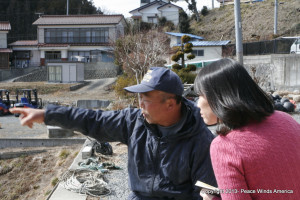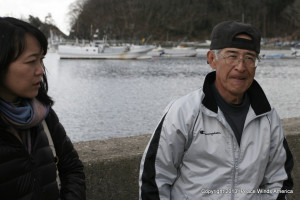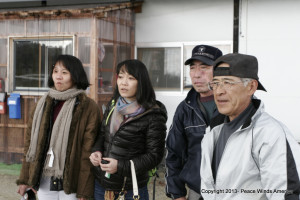New Sheds, New Hope: An Update from Tohoku
My coworker Ben and I visited Minamisanriku in early March to monitor project sites, meet with new district leaders and select shed recipients for the next phase of the project. It was a short and intense trip, but otherwise very fulfilling. I enjoyed meeting with all the district leaders and learning about how far they have come, and how far they have to go on their road to recovery.
We arrived in the middle of the wakeme and wakabe seaweed harvesting season, so we were served home processed seaweed everywhere we went! Yum!

Day 1- Arriving in Tohoku.
On the day we arrived in Tohoku, it was 32 degrees and snowing. Our first stop was to meet with our local partner for the Fishing Sheds Program, Grace Mission Tohoku (GMT). We have expanded the program to four new areas in Minamisanriku. Together with GMT we met with leaders in the four districts and announced the beneficiaries of the fishing sheds.
Takahashi-san, a leader from the Yoriki district had written PWA a letter last year. He asked us to please help his district with sheds.
…In my district, we lost 35 houses out of 45. We have lost over 100 fishing boats. All of our work areas have been destroyed. It is painful to look upon our fishing port…
When we met Takahashi-san at his home he was very happy to see us. His first words were, “Peace Winds America! I’ve been waiting for you for a long time!”
When we announced his district’s shed beneficiaries, he was very pleased with our selection. “These people really need a shed, and this will help them move forward little by little. Thank you, PWA, for coming to my district.”

Day 2- Great local partner, GMT.
On our second day, we visited past shed beneficiaries. As we met with the families, I couldn’t help but notice the trusting bond between shed recipients and our local partner, Grace Mission Tohoku.
When I met with Kunio Abe, the district leader asked me “Where’s Akemi-san? She is such a delightful person and I really enjoyed working with her while they were building sheds in my district.” There is great chemistry between us,” grinned Abe-san. I knew then that PWA has a great local partner.

Day 3- Tohoku still needs help.
As we drove around Minamisanriku, you could tell the recovery will take long time. Where once there were houses now are vast empty stretches of land. The tsunami not only took away people’s belongings but also erased many communities. As time passes people will be relocated from temporary housing to new residential areas, but when and where? People in the tsunami affected area face myriad problems ahead.
For the fishermen, to be able to return to their livelihoods, whether harvesting fish, farming oysters or cultivating seaweed, helps them to move forward with their lives.
“Our house was swept away by the tsunami and we live in temporary housing far from the sea,” said Mr. Oikawa. “At first we built our shed close to the ocean so we could store fishing equipment, but now we also use the shed to rest during work. We used to have a much, much larger building big enough to store equipment as well as work. This shed provides us with storage space and a place to invite our fishermen friends over for some hot tea.”
To them, fishing is their means of living, their way of life, and is the reason they are there. Our sheds support more than just occupations. They are places where neighboring fishermen bond with one another.

Thank you for your support.
Mari Poorman
READ MORE > about Peace Winds’ work in Tohoku.